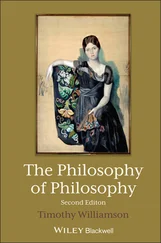Archimedes required only one fixed and immovable point to move the whole earth from its place, and I too can hope for great things if I can find even one small thing that is certain and unshakeable. 12
Since it was your ability to think that proved your existence, then perhaps you can build on that. For, if you are at this very moment “thinking of the Matrix,” is not it also certain that you know that you are “thinking of the Matrix”? It seems undeniably true that you are directly and unmistakably aware of your own immediate conscious mental state. Similarly, if you are perceiving a white page in front of you, you know that you are perceiving a white page in front of you. You just cannot jump to the conclusion that the page is “real,” in the sense that it has a separate existence apart from your perception. Not only do you have a direct awareness of your own thoughts and perceptions, but as Descartes put it, you know that you are a “thinking thing,” that is, you are the kind of being that is capable of having these thoughts and perceptions. This is not to say that you are the original source of these thoughts. It is always possible that they are somehow “pumped into your mind” from the outside. But regardless of the manner in which they arise, you must be capable of experiencing them.
So how deep does the rabbit hole really go? “Frighteningly deep” is the short answer. So long as you are willing to entertain the possibility of a Matrix‐type deception, then the only thing that you can be absolutely sure of is your own existence and the contents of your immediate mental state. Certainty about what the world is like outside your mind will always be unavailable to you. This conclusion does not sit very well with most people. And it did not for Descartes either. He tried to eliminate the possibility of such radical deceptions by proving that God exists. His thought was that if he could prove the existence of God as an all‐good and all‐powerful being, then he could rest assured that there was no malicious demon, for surely a benevolent God would not allow him to be deceived about his most clear and distinct perceptions. Unfortunately for Descartes, most philosophers agree that his argument for God fell short of the “proof” that he needed. In the end there may be no way to be absolutely certain that we are not the victims of a Matrix‐type deception.
Skepticism Outside the Matrix
How do you define real?
– Morpheus †
While we may not be able to prove that we are not in a Matrix‐type deception right now, this, of course, does not mean that we ought to believe that we are in the Matrix. While the Matrix scenario is a logical possibility, it is not the most likely explanation of our day‐to‐day experiences. And since Descartes's journey has shown that there is very little that we can know with absolute certainty , maybe we should lower our standards. After all, to be very certain about your beliefs is probably good enough for knowledge.
Shifting the standard from absolute certainty to merely a high degree of probability will not free us from skepticism – though many people mistakenly think that it does. They quickly fall into complacency and assume that they are very certain that the world is essentially just like it appears to be. They suppose that the images in our minds (coming to us through our senses) of smooth, solid, brown tables, soft, fuzzy, beige carpeting, and squishy, pink, bubblegum basically correspond to the world as it is outside our minds – reality in itself . This view, that the world outside our minds basically matches our perceptions of it, is called naive realism . While this view is quite common, there are plenty of reasons to think that it is false. The world is NOT just as it appears to be. Philosophers throughout history have argued this point, but in what follows I'll argue the case in a way that is inspired by the great twentieth‐century philosopher Bertrand Russell. 13
Suppose that I have purchased from Warner Brothers those big red chairs that Morpheus and Neo sat in during their first meeting. Imagine that I have invited you over and that you sit down in one of them. Let us be clear that in this example we are talking about a “real” chair. We are in my real living‐room – not in some Matrix‐type simulation, or in a film, but in real life. As you imagine yourself sitting there, think about what you would know with reasonable certainty about the chair. First off, if you are like most people, you will take it for granted that the chair exists . But what Russell asks us to do is to take seriously the seemingly stupid question: How do you know it exists? In a way that is reminiscent of Morpheus's own remarks, you would probably respond by saying that it exists because you feel it, see it, etc. You feel its support against your back; you run your hand across its smooth leather surface, feeling the contour of its shape; and you see its deep red color.
But take a moment to consider these perceptions. Is the chair really the color of red that it appears to be right now? Naive realism says of course it is. But Russell suggests that you should consider it again after lowering the lights. Notice that the color changes – the red becomes darker, deeper. If the original color was the real color, then what are we to say of the color it is now? Well, one might be tempted to say that while you cannot pinpoint the exact shade of red that is the “true” or “real” red of the chair, it is nevertheless some shade of red. But what reason do you have for thinking so? After all, the color changes not only with the brightness of the lighting, but also with the type of lighting. The color of the chair will look different under daylight, fluorescent light, candlelight, black light, etc. If under certain lighting conditions the chair looks more brown than red should we say it is brown also? And purple sometimes?
Now at this point you might think that it is not the chair that has changed, but the lights. Purple lights are purple, but the chair is not. But that is precisely Russell's point. As modern science tells us, color is not in the objects themselves at all. Red chairs, after all, are not made out of a bunch of little red atoms. Rather, the color that objects appear to us to be is caused by the wavelengths of the light that reaches our eyes from the direction of the object. But look what has happened. You thought that the chair (which really exists) was really red. But as it turns out, it is only the appearance of the chair that is red. The chair in itself is not.
Might naive realism have better luck with texture? To us the chair looks and feels very smooth. Many would assert that it truly is smooth. But is it really? Look at it through a microscope and the red leather exterior will appear very rough, bumpy, or even jagged. And imagine how this same leather might feel if our hands were about one‐tenth the size of an ant's – not smooth at all. The texture of the leather is clearly relative to one's perspective. And which of these perspectives is the real perspective? Russell contends that no perspective deserves that title. And solidity? How solid the chair seems will depend on your strength and weight. If you weighed 10 000 pounds, you certainly would not regard the chair as solid. And, according to the atomic theory of matter, the atoms that constitute the chair account for only a tiny fraction of the space it occupies. Thus, the chair is predominantly empty space – hardly the solid object that we perceive.
Shape is little help either. We know (or think we know) the shape of an object by what we see and feel. But what we see are colors, which we now realize are not really in the chair, and what we feel is its smoothness and solidity, yet these have turned out to be no more real than the color. So, again it comes down to perception. We seem to have absolutely no idea what the chair is like in itself – apart from our perceptions. 14 So consider once again the question of how you know that the chair exists. You thought you knew that it existed because of your various perceptions of it. But if we are right to regard these as appearances only, then you have lost your main reasons for thinking that the chair even exists at all!
Читать дальше












